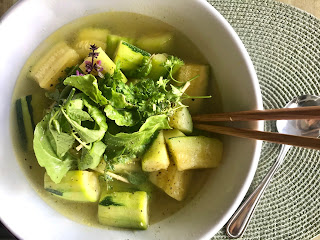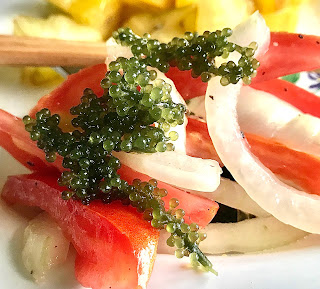
MULTI-HERB ZUCCHINI SOUP

A KIND OF KELP

In the kitchen rinsing the sea grapes in a cold bath, the otherwise sleepy kelp locked in a bottle for so long immediately begun to plump up double its size and the berries for a moment were like pearls. I saved the juice in the jar for later use (thinking to make salted century eggs, hardboiled, and immersing them in the kelp brine for weeks with additional fresh herbs, akin to a Chinese condiment of pickling plums). The execution of this prized salad has nothing to it, just combine the three ingredients and toss, and in of itself the sea grapes is delicious yet will attract by osmosis the tomatoes and onions to that reward in the mouth. I couldn't wait for the main dish I was also preparing at the same time (the broiled eggplant tamago still cooking in the pan, which should be a perfect pairing) yet had to eat the unbelievable salad I have on my plate, now. In the book Soul of the Chef, (also previously cited in this blog), mastering culinary techniques and kitchen ethos, it was noted, was a craft not unlike the talent of a smith. But he, too, will be hungry - and for the love of eating good food, after visually designing the menu's coherence, it's time to celebrate with swoon.
 Enter steaming sprouted brown rice, earthy eggplant tamago and sweet banana ketchup (second photo inset). After a few hours of hiking/swimming at Iao Valley in a storm (yes, a bit dangerous but there's a climate-drawn dance in the forest that's strangely beautiful to behold, and that's why I had stayed longer), and returning home wet and cold but rejuvenated body and spirit, comfort food was a must, and there was the sea grass salad and there was the big breakfast! I had a wonderful traditntal food of the Philippines to partake, and I couldn't ask for a better end of my weekend, this is like a Thanksgiving, with the help from a kelp.
Enter steaming sprouted brown rice, earthy eggplant tamago and sweet banana ketchup (second photo inset). After a few hours of hiking/swimming at Iao Valley in a storm (yes, a bit dangerous but there's a climate-drawn dance in the forest that's strangely beautiful to behold, and that's why I had stayed longer), and returning home wet and cold but rejuvenated body and spirit, comfort food was a must, and there was the sea grass salad and there was the big breakfast! I had a wonderful traditntal food of the Philippines to partake, and I couldn't ask for a better end of my weekend, this is like a Thanksgiving, with the help from a kelp.
BOURDAIN DAYS (one of the bests)

 |
| Tuileries Garden, Paris. Photo by C.G. (sitting in this chair reading my postcard) |
BOURDAIN DAYS (cont.)

It is only recently since reading a biography of the famed chef and father of the quintessential American cuisine, James Beard, in The Man Who Ate Too Much, that revealed to me he was born and raised in Portland, Ore. It was, however, his English mother, Elizabeth, who had informed his passion for food and, what would be, his defining simplicity yet elegant industry in the kitchen. Portland had been my homebase for a good amount of years (pre-NYC), and the Pacific Northwest, given this culinary legacy, had also been kind of a springboard for some of my most exciting, if not, sentimental world travels in search of the perfect food. It is fair to say that, artistically, I am a cook with a pen in hand. Sometimes I travel for the sole goal of writing, and the amazing food finds I discover purposely become the fuel for my brain. Poetry is always hungry, so to speak, because thinking never stops in the act of eating for the experience of gastronomical notes. And books make me hungry for beautiful letters and postcards to write. Poetry is the cause, and voyages are the effect on the romantic stamp of my letters. Food and words to me, after all these trips, find their home.
BOURDAIN DAYS

 |
| Paris, Ile-de-France, November 21, 2016 Photo by: C.G. |
The stack of to-read books in the living room are indications of a weekend mood. The previous workweek was a blink of time, but now the agency to rest out long has traction and good reason. Goethe had a pretty striking theory about plants. The poet wrote in the late eighteenth century that botanical vegetations and garden blooms, with the exclusion of hardwood trees, all shared vascular structures and/or systems of growth that determined exactness of physiology by their difference in manifestation: that genetically the stalks were wrapped up petals for their eventual unfolding, that “everything is leaf” about a plant, that the flower was merely the incumbent becoming of a pretty leaf. This outlandishness made me think of the late Chef Anthony Bourdain and his food travels around the world in search of the perfect plate. In France, the culinary scene there is a seamless manifestation of organic beauty, all is exquisite and coming from the same source of focused tradition of taste and interpretations. (The chef actually had died in Paris. It was, I think, heaven to him.) Of all his shows, the episode in Greece where he cooked for his staff was my favorite (it certainly wasn’t the usual dialogue between foodies and the politicalizations of history); instead he was his homey self in an outdoor kitchen feeding abundantly and deliciously for his peeps. I had never seen him cook on television before, so this broadcast was an illumination of his heart as a cook. The impresario journalist, the master chef, the home cook was distilled into one persona. White wine in hand while grilling the baby octopus with artichoke leaves, its tentacles still twitching life, shouting “plates please with lemons these babies will cook fast,” his intentional timing to eat at the right place at the right time was a commitment to the experience of food to a level of reverential. He was my hero. (Summer of 2013 a friend from New York let us borrow her uncle’s bungalow along the beach access road on Cayman Brac, in the Caribbean, and that 10-day vacation all I did was cook, a l a Bourdain— it helped that the uncle was a fisherman and had a small farm up the cliff near the lighthouse, and every morning he would show us his fresh catch and would always generously say to help ourselves in his vegetable garden.) There was news that he had also died of, I believe, cancer, a few years back. That had deeply saddened me. But my time there and with him, I had sensed he was happiest at sea and had a sense of wholeness around his plants and fruits. The other night I saw an old episode of Chef Toni’s show on CNN, Parts Unknown, when he was laying over in Taipei, Taiwan for 3 days (of course passionately eating everything he could try at the night market, or was recommended at restaurants by the in-the-know locals), and it brought a flood of memories and longing to me since Taiwan was, and still is, my favorite food (doe hua, sweet soybean custard swimming in ginger syrup) and nature (Bai Yen hot springs, an hour hike from town to mountain high where the waterfalls meets the volcanic spring at a confluence pool) and its people (will genuinely treat you like family) destination country in the world. I had stayed for a month in the fall of 2016 at Xindian, and my host became a brother figure, and I, an extension of his family, his sisters and his kids. In fact I had two brothers there at the time of my stay. The other was an ex-left-the-temple-life-monk and pursue his culinary passion to be a vegan chef. His small restaurant was just down the street from my homestay and it and his companionship became my sanctuary of inclusiveness in spite of my difference of culture (being a writer from the wild City of New York versus a gentle, contemplative man who seemed to me praying while in the act of cooking). His plates of blossoms and greens and purple rice were like altars of beautiful simplicity. Once at the prep table in the kitchen we were picking the leaves of the water spinach and I remember him saying, “I have enjoyed your company and your sharing of your poetic life and love for life, know that you will always have a brother in the same spirit here in Taiwan. Our heart’s journey, I think, are side by side.” I would have taken Bourdain to this sanctuary had I known him personally, had we discovered each other’s like-mindedness and reverence for food at the crossroads of our similar travels worldwide, pulled by the longings of the gastronomical earthbound creatures we are in search of heaven on earth.

Social icons